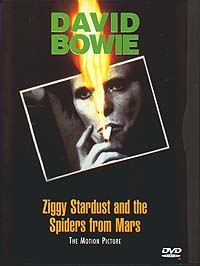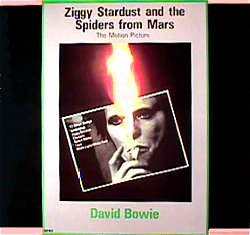 Companion
Companion![]() The
The  Companion
Companion
Home ¦ Index ¦ FAQ ¦ Encyclopaedia ¦ Timeline ¦ Songs ¦ Gallery ¦ E-mail
| Ziggy Stardust The Motion Picture (Movie/Video/DVD) |

See also: ZIGGY STARDUST: THE MOTION PICTURE Re-release (2002)
See also: ZIGGY STARDUST: THE MOTION PICTURE (1983) (The soundtrack)
See also: Hammersmith Odeon, London (The concert)
Radio/TV/Film/Video IndexFilm Recorded: 3 July 1973
Interviewer: Jeff Gold
Released: Film premiere at the Edinburgh Film Festival (31 August 1979). ABC TV (October 1974). Released world-wide on film in November 1983 (Thorn-EMI TVJ 90 21132). Released in video format in August 1984 (MGM 16500 VHS and BETA, and RCA / Columbia VH 91500 VHS and BE 91500 BETA). Released in laser disc format in 1985 in Japan by Light Year Entertainment (ID5329LY-A01-K).
20th Century Fox Ziggy Stardust: The Motion Picture 8 x 10 Promo picture
20th Century Fox Ziggy Stardust: The Motion Picture Press Release
Promo poster
The original concert songs and speeches from the Hammersmith Odeon concert on 3 July 1973 were as follows. However, those shown in red do not appear on the official film or soundtrack: The order is as follows (note that the film/video/DVD and soundtrack listings are different)
Main Title (Video/DVD - Index 1)
Clockwork Orange Theme (Video/DVD - Index 2 - labelled Beethoven Ninth Symphony)
Introduction
Hang Onto Yourself (Video/DVD - Index 3) (Soundtrack 1)
Ziggy Stardust (Video/DVD - Index 4) (Soundtrack 2)
Watch That Man (Video/DVD - Index 5) (Soundtrack 3)
Wild Eyed Boy From Freecloud (Video/DVD - Index 6) (Soundtrack 4) - All The Young Dudes (Video/DVD - Index 7) - Oh You Pretty Things (Video/DVD - Index 8) (Soundtrack 5)
Moonage Daydream (Video/DVD - Index 9) (Soundtrack 6)
Changes (Video/DVD - Index 10) (Soundtrack 12)
Space Oddity (Video/DVD - Index 11) (Soundtrack 7)
My Death (Video/DVD - Index 12) (Soundtrack 8)
Cracked Actor (Video/DVD - Index 13) (Soundtrack 9)
Time (Video/DVD - Index 14) (Soundtrack 10)
The Width Of A Circle (Video/DVD - Index 15) (Soundtrack 11)
Band introduction
Let's Spend The Night Together (Video/DVD - Index 16) (Soundtrack 13)
Suffragette City (Video/DVD - Index 17) (Soundtrack 14)
White Light-White Heat (Video/DVD - Index 18) (Soundtrack 15)
Jean Genie-Love Me Do
Round and Round
Farewell Speech (complete)
Rock 'n' Roll Suicide (Video/DVD - Index 19) (Soundtrack 16)
Pomp And Circumstance (Video/DVD - Index 20)The Hammersmith Odeon concert of 3 July 1973 was filmed by D.A Pennebaker, an American documentary maker who had filmed Dylan's' Don't Look Back (1967) and the rock movie Monteroy Pop (1967). Bowie wanted the same sort of cinema-verite techniques used for the Hammersmith appearance. In 1999 Pennebacker was asked why he filmed the last Ziggy Stardust concert?
Pennebaker: "Well, he is incredible to watch. I mean, I could see myself getting a hard-on just looking at him sometimes, which is ridiculous. But I think that the reason we made it was because RCA said, we have this guy and he's going to do a concert, maybe the last one he's going to do, and you've got to go make a film. "I thought they said Bolan. I thought it was Marc Bolan I was going to do. And I was very excited because I really dug glitter rock. So I kind of set off with the wrong guy in mind. But I've spent time with Bowie, and I've seen him go into his head. He just disappears. He's like Dylan. He has someplace where it's just all music, and he's all alone."
Promo poster
While ZIGGY STARDUST: THE MOTION PICTURE is a valuable record of this historic concert, the resulting 35mm film, apparently first conceived as an early video-disc (CED) experiment for RCA, disappoints somewhat in being rather dark and jerky. Also as noted, historically it is minus the live performances of "Jean Genie/Love Me Do" and "Round and Round."
Ziggy Lives: Stardust Memories - A review of Ziggy Stardust: The Motion Picture.
Sixty minutes of the concert were first shown by ABC TV in the US in October 1974, while the full ninety-minute film was premiered at the Edinburgh Film Festival on the 31st August 1979.
RCA Selectavision videodisc (1984)
Images from unreleased silent 8mm footage filmed from the presspit at
the Oxford New Theatre (25-26th June) and the Hammersmith Odeon Shows (2nd-3rd July).The concert was released world-wide on in movie theatres and on video in November 1983 as ZIGGY STARDUST AND THE SPIDERS FROM MARS: THE MOTION PICTURE. The film was also released as an RCA Selectavision video disc in 1984. "Selectavision" was a special format introduced by RCA for the home entertainment industry. RCA produced special machines (Selectavision players) and video-discs in the late 1970's, and only stopped making both in 1985 when VHS and in particular laser-disc became more popular. The Selectavision video disc looks and plays like a regular LP record album (the player's special stylus puts out both an audio & video signal) and is kept in a caddy which is a flat shaped holder that displays the movie information on both sides of the outside.
Video Jackets
The film was released in video format in August 1984 (MGM 16500 VHS and BETA, and RCA / Columbia VH 91500 VHS and BE 91500 BETA) and in the UK made it to #1 on the video charts.

Light Year Entertainment Laser Disc (1985)
The film was released in laser disc format in 1985 in Japan by Light Year Entertainment (ID5329LY-A01-K) and reissued by the same company in 1998 ((IMAGE LR-54). For the original 1985 release "Oh! You Pretty Things" was labelled as "Oh! You Beautiful Things" but this was corrected for the 1998 re-issue.
Japanese Laser Disc
Light Year Entertainment Laser Disc Reissue (1998)
The DVD for Ziggy Stardust And The Spiders From Mar: The Motion Picture was released on 4 November 1998.

Lightyear NTSC DVD ID4704LY (1998)
"Rock Legend David Bowie was the bizarre, ineffable Ziggy Stardust. Now in this timeless concert film, you'll see the inimitable Bowie perform some of his most unforgettable songs. Rock n Roll has never been more imaginative or sounded so good." - DVD Liner notes
Original DVD Review by Colin Jacobson
Title: David Bowie: Ziggy Stardust and the Spiders from Mars (1982)
Studio Line: Image Entertainment
Director: D.A. Pennebaker
DVD: Standard 1.33:1; audio English PCM Stereo; subtitles none; not closed-captioned; single sided - single layered; 20 chapters; rated PG; 89 min. date 11/10/98.
Supplements: None.
Picture/Sound/Extras Rating: D/D/F
Ziggy Stardust and the Spiders From Mars: The Motion Picture appears in an aspect ratio of 1.33:1 on this single-sided, single-layered DVD; due to those dimensions, the image has not been enhanced for 16X9 televisions. Ziggy was a tough picture to rate because of the original elements. At best, it was never going to be very attractive, as the film was shot on 16mm film and done under rough conditions. Clearly no adaptations were made to the presentation to improve the visual elements of the movie. This meant that the flick looked consistently terrible, but I can’t blame the DVD transfer for that; it’s always been an ugly movie and it always will be.
That said, I still was somewhat surprised at just how unattractive the image was. Sharpness tended to be rather dull and flat. Some close-ups came across as acceptably distinct, but most of the time the picture displayed a bland and fuzzy impression. The overall look was very soft and tentative, with little definition to be found. Moiré effects and jagged edges caused no concerns, but print flaws were a major issue. A variety of marks, scratches, blotches, hairs and general debris showed up throughout the movie, and the image displayed a tremendous amount of grain.
Colors consistently appeared drab and bland. Basically two tones dominated: red and yellow. Due to the lighting schemes utilized, those were really the ones hues that could be seen during the movie. The yellow tones came across as flat but acceptably clear, but the red caused definite concerns. They rendered the picture as very heavy and indistinct, and they created an impenetrable look at times. The colors simply seemed to be thick and unrealistic.
Black levels tended to appear murky and inky, and they forced a very dense look to many scenes. Shadow detail was a mess much of the time. Low-light situations both on stage and in crowd shots looked excessively dark. At times, some of the audience images were almost totally unwatchable, especially during the first half of the movie; a few scenes depicted a screen that was virtually black!
For many concert movies, adaptations to the normal stage set-up are made to allow the show to be filmed. Obviously none of these alterations occurred for Ziggy. As a result, it offered one of the least attractive images I’ve ever seen, and the addition of many print flaws and weak focus meant that it earned a very substandard “D” for picture quality.
While the image was ugly, I didn’t feel too surprised that it looked so bad. This is an old and inexpensive project; it should have been more attractive, but I didn’t expect it to be radically stronger. However, the quality of the PCM stereo soundtrack of Ziggy could and should have been superior to the crummy mix heard here.
For most of the film, the stereo imaging seemed to be moderately indistinct but acceptable. However, it started very poorly. For the first few songs - until the “Freecloud” medley - the track used very hard localization. All audio came from either the left or the right speakers and didn’t blend together at all. After the initial few tunes, though, the integration became more satisfying. Placement of instruments still seemed less than distinct and crisp, but the audio spread reasonably well across the channels, and some decent effects occurred at times; for example, during “Moonage Daydream”, Ronson’s guitar histrionics flew wildly about the soundstage.
Where the soundtrack really died, however, related to the quality of the audio. Midrange almost totally dominated the piece, as very little in the way of distinct bass or clear highs occurred. The track sounded worst early in the film, mainly until the stereo imaging improved. For the first few songs, the mix sounded so bad that it appeared to have been recorded from outside the venue; the muddy, insubstantial music came across with no definition or presence.
Although the situation improved after a few numbers, the track remained drab and thin. In general, the audio seemed to be either flat or shrill, with no songs that came across as clear and lively. Highs appeared harsh and screechy, while bass response was boomy when it existed at all. Some popping and distortion occurred at times, especially during early tracks like “Watch That Man”. Frankly, the audio seemed to have been taped by someone with a cassette deck from the crowd.
What made the poor quality more upsetting was the fact that much stronger recordings clearly exist. If you hear the album version of this mix, you’ll witness very solid audio. That record offered a good concert recording for the era that showed good clarity to the highs and nice depth to the bass. The difference truly is night and day between the two recordings, and that fact rendered the DVD an even bigger disaster.
Completing the trifecta of terror are the DVD’s extras. There aren’t any.
As a massive Bowie fan, I’d love to be able to recommend Ziggy Stardust and the Spiders From Mars: The Motion Picture. The concert offered a decent look at early-Seventies Bowie; it wasn’t the greatest performance, but it had enough good moments to be worth a look. However, the DVD is a disaster. Picture and sound quality are atrocious, and the package lacks any extras. Ziggy should be left for the absolute die-hards like me. I wouldn’t recommend this for anyone new to the world of Bowie; it’ll quickly turn them off and lead them to avoid further examination of his work.---This page last modified: 18/12/18---
